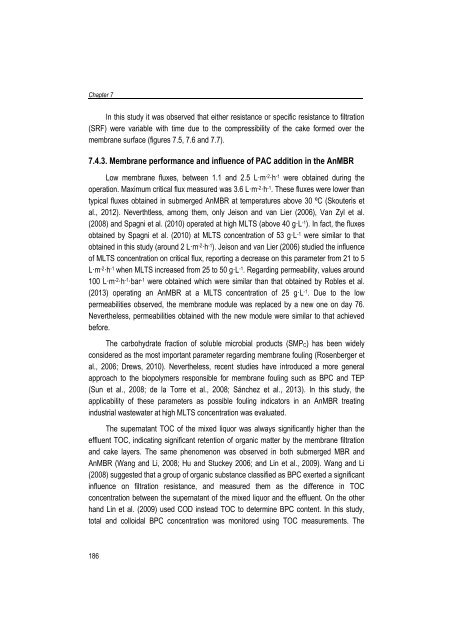Combining submerged membrane technology with anaerobic and ...
Combining submerged membrane technology with anaerobic and ...
Combining submerged membrane technology with anaerobic and ...
Create successful ePaper yourself
Turn your PDF publications into a flip-book with our unique Google optimized e-Paper software.
Chapter 7In this study it was observed that either resistance or specific resistance to filtration(SRF) were variable <strong>with</strong> time due to the compressibility of the cake formed over the<strong>membrane</strong> surface (figures 7.5, 7.6 <strong>and</strong> 7.7).7.4.3. Membrane performance <strong>and</strong> influence of PAC addition in the AnMBRLow <strong>membrane</strong> fluxes, between 1.1 <strong>and</strong> 2.5 L·m -2·h -1 were obtained during theoperation. Maximum critical flux measured was 3.6 L·m -2·h -1 . These fluxes were lower thantypical fluxes obtained in <strong>submerged</strong> AnMBR at temperatures above 30 ºC (Skouteris etal., 2012). Neverthtless, among them, only Jeison <strong>and</strong> van Lier (2006), Van Zyl et al.(2008) <strong>and</strong> Spagni et al. (2010) operated at high MLTS (above 40 g·L -1 ). In fact, the fluxesobtained by Spagni et al. (2010) at MLTS concentration of 53 g·L -1 were similar to thatobtained in this study (around 2 L·m -2·h -1 ). Jeison <strong>and</strong> van Lier (2006) studied the influenceof MLTS concentration on critical flux, reporting a decrease on this parameter from 21 to 5L·m -2·h -1 when MLTS increased from 25 to 50 g·L -1 . Regarding permeability, values around100 L·m -2·h -1·bar -1 were obtained which were similar than that obtained by Robles et al.(2013) operating an AnMBR at a MLTS concentration of 25 g·L -1 . Due to the lowpermeabilities observed, the <strong>membrane</strong> module was replaced by a new one on day 76.Nevertheless, permeabilities obtained <strong>with</strong> the new module were similar to that achievedbefore.The carbohydrate fraction of soluble microbial products (SMP C) has been widelyconsidered as the most important parameter regarding <strong>membrane</strong> fouling (Rosenberger etal., 2006; Drews, 2010). Nevertheless, recent studies have introduced a more generalapproach to the biopolymers responsible for <strong>membrane</strong> fouling such as BPC <strong>and</strong> TEP(Sun et al., 2008; de la Torre et al., 2008; Sánchez et al., 2013). In this study, theapplicability of these parameters as possible fouling indicators in an AnMBR treatingindustrial wastewater at high MLTS concentration was evaluated.The supernatant TOC of the mixed liquor was always significantly higher than theeffluent TOC, indicating significant retention of organic matter by the <strong>membrane</strong> filtration<strong>and</strong> cake layers. The same phenomenon was observed in both <strong>submerged</strong> MBR <strong>and</strong>AnMBR (Wang <strong>and</strong> Li, 2008; Hu <strong>and</strong> Stuckey 2006; <strong>and</strong> Lin et al., 2009). Wang <strong>and</strong> Li(2008) suggested that a group of organic substance classified as BPC exerted a significantinfluence on filtration resistance, <strong>and</strong> measured them as the difference in TOCconcentration between the supernatant of the mixed liquor <strong>and</strong> the effluent. On the otherh<strong>and</strong> Lin et al. (2009) used COD instead TOC to determine BPC content. In this study,total <strong>and</strong> colloidal BPC concentration was monitored using TOC measurements. The186
















